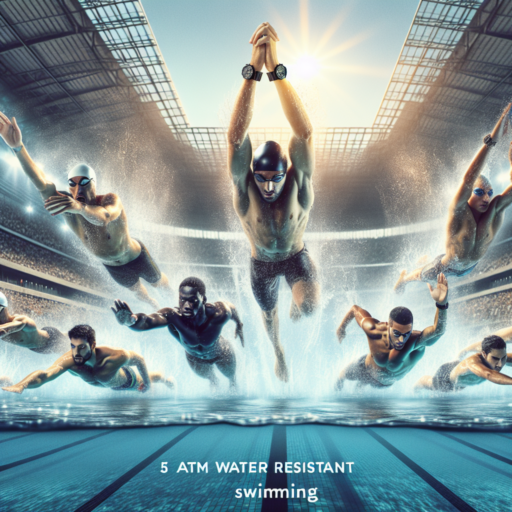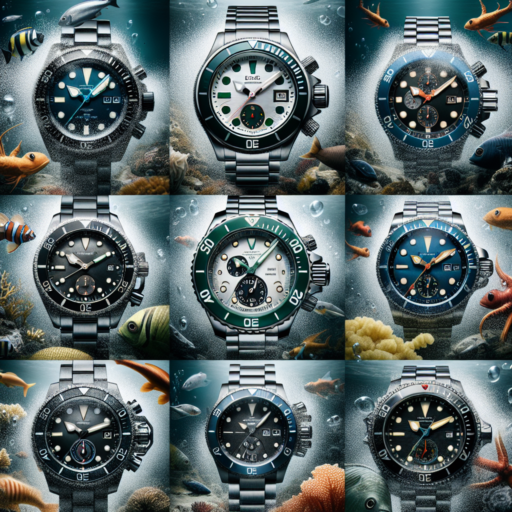No se han encontrado productos.
What Does 5 ATM Water Resistance Mean for Swimmers?
Understanding the term 5 ATM water resistance is crucial for swimmers and those involved in water activities. This specification signifies that a device, often a watch, has been tested to withstand pressures equivalent to a depth of 50 meters (or about 164 feet) underwater. Though it might seem straightforward, this rating has specific implications for swimmers.
Firstly, it’s important to note that the 5 ATM rating does not necessarily mean you can use the device for prolonged swimming sessions at depths of 50 meters. Instead, it indicates the device can survive splashes, brief submersion, and possibly swimming on the surface without sustaining damage. This distinction is vital for swimmers who need their gear to be reliable under various aquatic conditions.
Moreover, certain precautions should be taken despite the rating. Avoiding high-impact water activities, such as diving or water-skiing, can ensure the longevity of a 5 ATM-rated device. It’s also recommended to not manipulate buttons or interfaces while the device is submerged, as this can compromise its water resistance integrity. Being aware of these limitations allows swimmers to use their 5 ATM devices optimally within the context of their water-based activities.
Understanding the Durability of 5 ATM Water Resistant Watches
When it comes to selecting a reliable watch, understanding the specifics about water resistance ratings is essential. Watches marked with a 5 ATM (atmospheres) rating offer a moderate level of water resistance, ideally suited for everyday wear and light water activities. Diving deep into the durability of 5 ATM water resistant watches helps elucidate why they stand out in the realm of wearable technology.
At the core of a 5 ATM water resistant watch is its capability to withstand pressures equivalent to a depth of 50 meters (approximately 164 feet). This specification does not necessarily suggest that these watches are suitable for diving but indicates their resilience against water ingress in situations such as swimming or showering. The construction elements that contribute to this durability include specialized seals and gaskets which prevent water from penetrating the watch case, safeguarding its internal mechanisms.
Additionally, the material choice for the watch case and crystal also plays a crucial role in enhancing water resistance. Stainless steel, polymers, and sapphire or mineral glass are commonly employed due to their strong resistance to both corrosion and physical abrasion. It’s the synergy between these materials and the watch’s design that fortifies 5 ATM water resistant watches against everyday water encounters, accentuating their durability.
The Best 5 ATM Water Resistant Watches for Swimming
Finding the perfect watch that balances functionality and style for swimming can be challenging. Watches with a 5 ATM water resistance rating are often the go-to choice for swimmers and aquatic enthusiasts, providing durability against water pressure up to 50 meters deep. These reliable timepieces not only keep accurate time but also withstand the rigors of frequent swimming sessions, making them an essential accessory for anyone who spends a lot of time in the water.
When selecting the best 5 ATM water-resistant watches for swimming, it’s important to consider not just the water resistance level, but also the design, build quality, and additional features like timekeeping accuracy and readability underwater. The ideal watch combines these elements to offer a blend of functionality and style, ensuring that you can keep track of time whether you’re in the pool or open water. Moreover, durability is a key factor, as these watches are designed to resist the corrosive effects of chlorine and saltwater, preserving their appearance and functionality over time.
Among the top contenders, features such as luminous hands and markers, secure straps, and robust materials are common, ensuring that your watch remains intact and visible in any swimming condition. Additionally, many of these watches also come equipped with timers and stopwatches, useful tools for swimmers looking to track their progress and performance. Whether you’re a casual swimmer or a competitive athlete, a 5 ATM water-resistant watch is a versatile companion that meets the demands of various water activities without compromising on style or performance.
How to Properly Use and Maintain Your 5 ATM Water Resistant Watch
Understanding the capabilities of your 5 ATM water resistant watch is crucial for ensuring its longevity and performance. A 5 ATM rating signifies that your watch can withstand pressures equivalent to a depth of 50 meters, making it suitable for light water activities but not for diving or high-speed water sports. Proper use and maintenance are key to preserving its water-resistant qualities over time.
Proper Usage of Your 5 ATM Watch
To make the most out of your 5 ATM water resistant watch, avoid exposing it to water under conditions that exceed its resistance rating. While it is designed to handle activities like showering, swimming, or fishing, always ensure the crown is firmly secured before submerging the watch in water. Furthermore, exposure to chemicals such as soaps, solvents, or seawater can degrade the water-resistant seals over time, so it’s advisable to rinse your watch with fresh water after exposure to harsh substances or environments.
Maintaining Your 5 ATM Watch
Maintenance plays a pivotal role in the performance of your 5 ATM water resistant watch. Regular servicing, ideally every 1 to 2 years, is recommended to check the integrity of the seals and gaskets, which are crucial for maintaining its water resistance. A simple test can be done by a professional to ensure that the water-resistant properties are intact. Additionally, avoid opening the back of the watch yourself, as this can compromise its water-resistant seal. For battery replacements or internal repairs, seek the services of a certified watch technician who can preserve the integrity of the water-resistant features during and after service.
Properly using and maintaining your 5 ATM water resistant watch not only prolongs its life but also ensures that it remains a reliable companion for your water-related adventures. Remember, the key to preserving your watch’s water resistance lies in understanding its limitations, adhering to recommended usage, and committing to regular maintenance checks.
Real-Life Experiences: Swimmers’ Reviews on 5 ATM Water Resistant Watches
When it comes to choosing the perfect water-resistant watch for swimming, real-life experiences play a crucial role. Swimmers often look for reliability, accuracy, and durability in a watch that can withstand the rigors of aquatic activities. Reviews from seasoned swimmers about 5 ATM water resistant watches highlight a variety of experiences, showing a clear picture of what works best under the waters.
To understand the value these watches bring to avid swimmers, it’s important to delve into the specifics. Swimmers prioritize features like the readability of the watch under water, the comfort of the wristband during vigorous movements, and of course, the accuracy of the timekeeping mechanism when exposed to prolonged periods in water. Their reviews often touch on how these watches fare in both pool swimming and open-water scenarios, offering insights into their performance across different water environments.
Moreover, the durability of 5 ATM watches after repeated exposure to chlorine, saltwater, and varying water temperatures is a recurring theme in these evaluations. Swimmers appreciate watches that not only survive these conditions but continue to perform with the same efficacy. The feedback on battery life after sustaining water resistance is equally crucial. Swimmers rely on these detailed reviews to make informed decisions about which watches truly stand up to their waterproof claims, ensuring their investment is worthwhile.
Comparing 5 ATM Water Resistance with Other Levels: What Swimmers Need to Know
When selecting a water-resistant watch, it’s crucial for swimmers to understand how 5 ATM resistance stacks against other levels. The term «ATM» stands for atmospheres, with each level indicating the pressure a device can withstand below water. While a 5 ATM rating refers to the watch’s ability to resist pressure equivalent to a depth of 50 meters, how does it compare with other common water resistance levels?
Differences Between 3 ATM, 5 ATM, and 10 ATM Ratings
Starting with 3 ATM water resistance, these devices are suitable for everyday use and can withstand brief immersion in water, such as hand washing or rain. However, they are not recommended for swimming. On an enhanced level, 5 ATM watches are designed to endure not just splashes but also swimming activities. It’s a significant upgrade for those who spend considerable time in water. Doubling the endurance, devices with a 10 ATM rating are fit for swimming and snorkeling, offering greater versatility for aquatic adventurers. The distinction highlights 5 ATM as a middle ground, balancing protection and practicality for casual to moderate swimmers.
Understanding Limitations and Suitability
While a 5 ATM water resistance is suitable for swimming, it’s important to recognize its limitations. This rating does not implicitly endorse diving or high-impact water sports. For swimmers who frequently dive or engage in activities that involve significant changes in pressure, opting for a higher water resistance level, such as 10 ATM or more, is advisable. Each swimmer’s needs should dictate the choice of water resistance level, factoring in their usual activities and the environmental conditions they face.
Essential Features to Look for in a 5 ATM Water Resistant Swimming Watch
When it comes to selecting a 5 ATM water-resistant swimming watch, there are several essential features that you should look for to enhance your swimming activities. These watches are not only designed to withstand depths of up to 50 meters, but they also come with functionalities that cater to the needs of both casual swimmers and professional athletes. Knowing what features are crucial can significantly influence your buying decision, ensuring that you choose a watch that aligns with your aquatic adventures.
1. Durability and Material Quality
The very first aspect to consider is the durability and material quality of the watch. A high-quality 5 ATM swimming watch should be crafted from materials that can withstand harsh pool chemicals, saltwater, and the continuous pressure changes experienced during swimming. Look for watches made with stainless steel or high-grade silicone bands and scratch-resistant sapphire or mineral glass to ensure longevity and durability.
2. Advanced Swim Metrics
Next, an indispensable feature for serious swimmers is the presence of advanced swim metrics. A watch that offers detailed analytics such as lap counts, stroke detection, pace, and even SWOLF scores can provide invaluable insights into your performance. These metrics help in setting benchmarks and achieving swimming efficiency, making them a must-have for anyone looking to improve their swimming skills.
3. Battery Life and Connectivity
Lastly, consider the battery life and connectivity options of the 5 ATM water-resistant swimming watch. Opt for models that offer long-lasting battery life to minimize charging interruptions during your training sessions. Additionally, watches that feature connectivity to smartphones or tablets through Bluetooth or Wi-Fi can effortlessly sync your swim data to your favorite fitness apps, allowing for seamless tracking and analysis of your progress over time.
Tips for Choosing the Right 5 ATM Watch for Swimming and Diving
When selecting the perfect 5 ATM watch for your swimming and diving adventures, understanding the essential features that meet your specific needs is crucial. A 5 ATM rating signifies that a watch is water-resistant up to 50 meters or 164 feet, making it suitable for light swimming but not necessarily for diving activities where deeper depths are involved. In this light, it’s essential to consider the durability, materials, and additional functionalities that align with your water-related activities.
Consider the Material and Build Quality
The material of your watch plays a significant role in its longevity and resistance to water pressure. For swimming and diving, look for watches made with a corrosion-resistant material like stainless steel, titanium, or high-grade plastic. The build quality, especially the sealing of the watch case, determines how well the watch can withstand water pressure without leaking. Ensure the band is also made of a durable material, such as rubber or silicone, to withstand frequent exposure to water without deteriorating.
Check for Essential Features
When choosing a 5 ATM watch for swimming and diving, prioritize features that enhance its utility underwater. Luminous hands and markers are invaluable for visibility in low light conditions underwater. Also, consider a watch with a unidirectional rotating bezel, which helps monitor elapsed time underwater safely. Finally, don’t overlook the importance of a secure, adjustable band that won’t come loose during your activities.
By focusing on the material, build quality, and key features suited to your aquatic endeavors, you’ll find a 5 ATM watch that not only meets your needs but also enhances your swimming and diving experience. Remember, the ideal watch should offer a balance between functionality and durability, ensuring it can accompany you on many water-filled adventures without fail.
FAQs: Common Questions About 5 ATM Water Resistance Answered
Understanding the intricacies of 5 ATM water resistance can clear up many common concerns and questions for watch enthusiasts and everyday users. This level of water resistance is a standard among various watches, promising a blend of functionality and durability for various water-related activities.
What Does 5 ATM Stand For?
When a watch is described as 5 ATM water-resistant, it signifies that it’s designed to withstand pressures equivalent to a depth of 50 meters underwater. This term, ATM, stands for atmospheres, with 1 ATM equaling the pressure at sea level. It’s a crucial feature for those who lead active lifestyles but remember, 5 ATM resistance does not mean the watch can be used for all types of aquatic activities.
Can I Swim with a 5 ATM Water-Resistant Watch?
While a 5 ATM water-resistant watch is suitable for light swimming, it’s essential to understand its limitations. Such watches are perfect for shallow water activities but are not intended for diving or high-impact water sports. The resistance is tested under static conditions, and movement in water increases pressure, potentially exceeding the limits of 5 ATM resistance. Always consult the manufacturer’s guidelines before taking your watch for a swim.
The Science Behind 5 ATM Water Resistance: How It Protects Your Watch
Understanding the science behind 5 ATM water resistance is vital for anyone who wants to ensure the longevity and functionality of their timepiece when exposed to water. This level of resistance is not just a random figure; it’s a metric indicating that your watch can withstand pressures equivalent to a depth of 50 meters or approximately 164 feet underwater. This doesn’t mean you should dive to these depths with your watch, but rather, it tells you about the engineering marvel that keeps your watch safe during everyday water exposures.
How Does 5 ATM Resistance Work?
The principle of 5 ATM water resistance is rooted in the watch’s construction. Manufacturers use specialized seals and gaskets made from rubber, nylon, or Teflon to create barriers at potential entry points for water, such as the case back, crown, and crystal. This level of craftsmanship ensures that your watch is not only safeguarded against incidental water contact, such as rain or hand washing, but it’s also suitable for swimming or snorkeling. However, it’s important to note that activities involving high-velocity water or deeper submersion could potentially compromise the watch’s integrity.
Pressure Testing for 5 ATM Rating
Before a watch receives a 5 ATM rating, it undergoes rigorous pressure testing to emulate the conditions it would face at a depth of 50 meters. These tests are critical in establishing a watch’s durability and water resistance. Manufacturers use a dry method, which involves placing the watch in a chamber and gradually increasing the air pressure, and a wet method, where the watch is submerged, and pressure is applied. This dual-testing scenario ensures the watch meets the stringent requirements to be considered 5 ATM water-resistant, offering peace of mind to its wearers.
The technical prowess involved in achieving the 5 ATM rating is a testament to the intricate engineering and design that goes into protecting your watch against water ingress. By understanding these mechanisms, individuals can better appreciate the value and reliability of their water-resistant timepieces, knowing that they are designed to perform under specific wet conditions without compromising their functionality.




